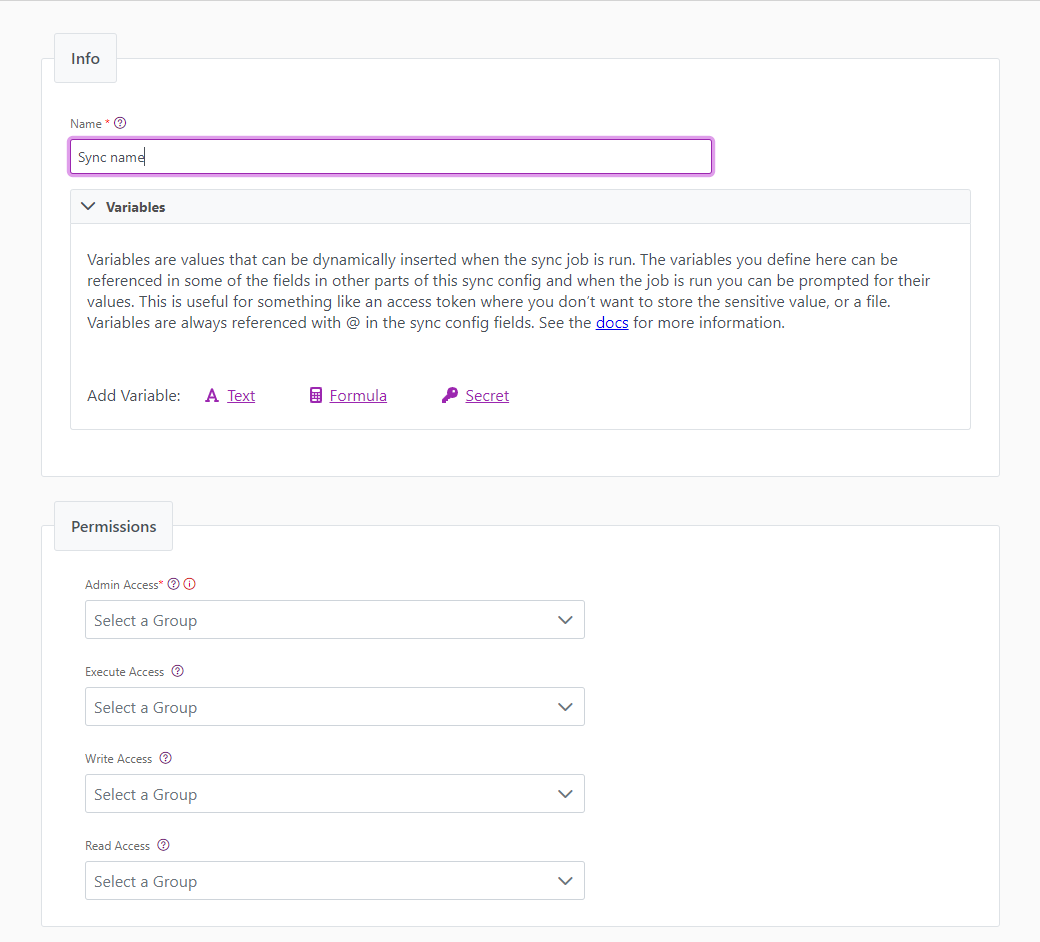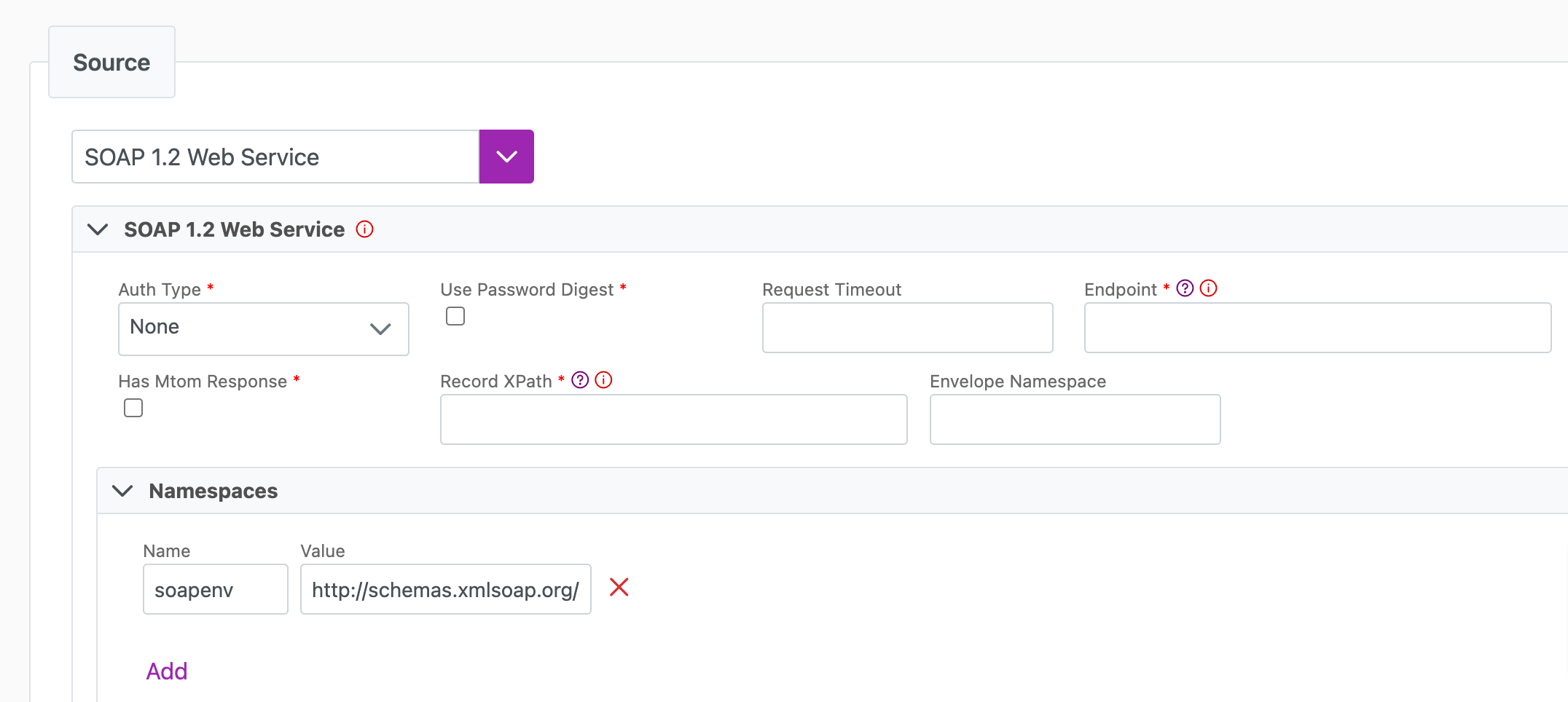SOAP 1.2 web service (Cinchy Event Triggered)
Overview
SOAP (Simple Object Access Protocol) is an XML-based protocol for accessing web services over HTTP.
SOAP allows applications running on different operating systems to communicate using different technologies and programming languages. You can use SOAP APIs to create, retrieve, update or delete records, such as passwords, accounts, leads, and custom objects, from a server.
\
Info tab
You can find the parameters in the Info tab below (Image 1).
Values
| Parameter | Description | Example |
|---|---|---|
| Title | Mandatory. Input a name for your data sync | SOAP 1.2 (CDC) to Cinchy |
| Description | Optional. Add in a description for your sync. There is a 500 character limit in thie field. | |
| Variables | Optional. Review our documentation on Variables here for more information about this field. | |
| Permissions | Data syncs are role based access systems where you can give specific groups read, write, execute, and/or all of the above with admin access. Inputting at least an Admin Group is mandatory. |

Source tab
The following table outlines the mandatory and optional parameters you will find on the Source tab (Image 2).
- Listener Details
- Source Details
- Schema
- Filter
Listener Config
To configure a SOAP 1.2 (Cinchy Event Triggered) connection, you must configure a listener via the Listener Config table. When you create a sync in the table, do the following:
- Enter the name of your Listener.
- Enter
Cinchy CDCunder Event Connector Type. - Create your Topic JSON.
For more information, review the Cinchy Event Broker/CDC Listener Configuration values here, and then navigate to the Listener Config table to input a new row.
When setting up your listener configuration for your data sync, keeping the following constraints in mind:
- Column names in the listener config shouldn't contain spaces. If they do, they will be automatically removed. For example, a column named Companyv Name will become the replacement parameter @CompanyName.
- The replacement parameter names are case sensitive.
- Column names in the listener config shouldn't be prefixes of other column
names. For example, if you have a column called Name, you shouldn't have
another called Name2 as the value of @Name2 may end up being replaced
by the value of @Name suffixed with a
2.
Example Listener Configuration
The example below is an example of a Topic JSON for the Listener Config.
{
"tableGuid": "420c1851-31ed-4ada-a71b-31659bca6f92",
"fields": [
{
"column": "Cinchy Id",
"alias": "CinchyId"
},
{
"column": "Company Name",
"alias": "CompanyName"
}
]
}
The following parameters will help to define your data sync source and how it functions.
Namespaces
You are required to define every Namespace present in your SOAP request, or in the SOAP response. You must define an envelope schema in the Namespace section. Use the following schema as a default:
- Name: soapenv
- Value: "http://www.w3.org/2003/05/soap-envelope"
| Parameter | Description | Example |
|---|---|---|
| Namespaces - Name | Name of your SOAP namespace tags in request and response. | "soapenv" |
| Namespaces - Value | URL describing this namespace in the response. | "http://schemas.xmlsoap.org/soap/envelope/" |
SOAP 1.2 parameters
| Parameter | Description | Example |
|---|---|---|
| authType | Mandatory. Select the type of authentication you wish to use in this sync: None, WSSE, Basic. | Basic |
| Use Password Digest | Use only with WSSE authType and Password Type as PasswordDigest. Otherwise, leave unchecked. | |
| Request Timeout | Mandatory. Set a timeout in milliseconds. No maximum value. Minimum greater than 0. Default is 100 milliseconds. | 2000 |
| Endpoint | Mandatory. Contains your SOAP 1.2 Web Service API endpoint. | |
| Has Mtom Response | Required to be true if SOAP API response contains an attachment outside the message. | |
| Record Xpath | Mandatory. The Xpath to select records to extract from the SOAP response. Starts with ‘//’ followed by the tag name. | |
| Envelope Namespace | Namespace prefix for SOAP request elements. Make sure the envelope matches the Namespace definition for the envelope. | "soapenv" |

The Schema section is where you define which source columns you want to sync in your connection. You can repeat the values for multiple columns.
| Parameter | Description | Example |
|---|---|---|
| Name | Mandatory. The name of your column as it appears in the source. | Name |
| Alias | Optional. You may choose to use an alias on your column so that it has a different name in the data sync. | |
| Data Type | Mandatory. The data type of the column values. | Text |
| Description | Optional. You may choose to add a description to your column. |
Select Show Advanced for more options for the Schema section.
| Parameter | Description | Example |
|---|---|---|
| Mandatory |
| |
| Validate Data |
| |
| Trim Whitespace | Optional if data type = text. For Text data types, you can choose whether to trim the whitespace. | |
| Max Length | Optional if data type = text. You can input a numerical value in this field that represents the maximum length of the data that can be synced in your column. If the value is exceeded, the row will be rejected (you can find this error in the Execution Log). |
You can choose to add in a Transformation > String Replacement by inputting the following:
| Parameter | Description | Example |
|---|---|---|
| Pattern | Mandatory if using a Transformation. The pattern for your string replacement. | |
| Replacement | What you want to replace your pattern with. |
Note that you can have more than one String Replacement
You have the option to add a source filter to your data sync. Please review the documentation here for more information on source filters.
Next steps
- Configure your Destination
- Define your Sync Actions.
- Add in your Post Sync Scripts, if required.
- Click Jobs > Start a Job to begin your sync.